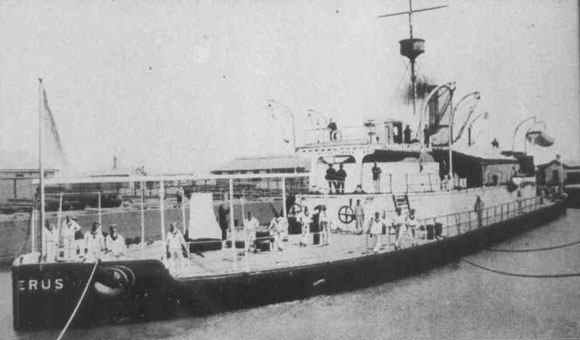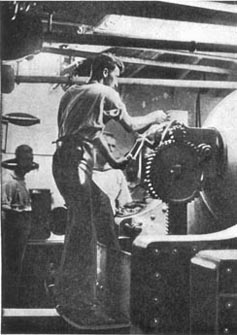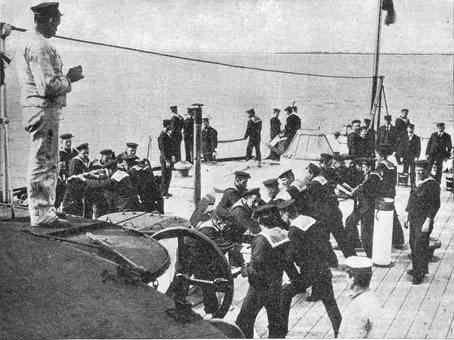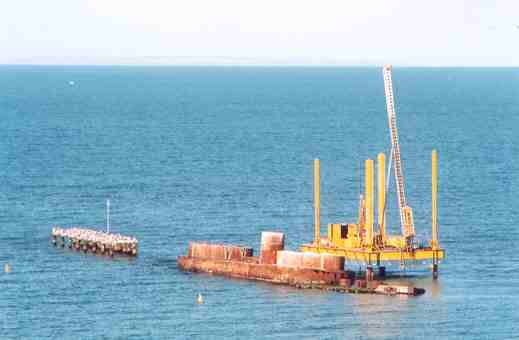
c.1880
photo courtesy of
"Brian Hutchins Real Estate Agency" Black Rock.

2002
photo by John Rogers
Prior to federation Victoria's defences were exposed as the British naval presence was located in far away Sydney. As a result a powerful 16 ship fleet evolved. This Victorian Navy was the largest of the Australian colonial navies. Her Majesty's Victorian Ship Cerberus was for 30 years the main unit of this "Great Southern Fleet".
Launched in 1868 Cerberus was purpose built for Port Phillip Bay to guard against foreign invasion. This revolutionary warship was a radical departure from the wooden warships with sails that had previously dominated the navies of the world. Cerberus not only was the first British warship to be powered purely by steam but was the first ship in the world to mount rotating gun turrets on a central superstructure. This became a key element in modern Battleship development. Steam engines were not only used to move Cerberus but were also used throughout the ship. Rotating the gun turrets, raising the anchor, ventilating the ship, hoisting ashes from the stoke hole and pumping water out of the double bottom were all performed by steam power. After its arrival in Victoria a locally designed and built hydraulic steam steering system was fitted thereby further reducing the manpower demands on a small colonial navy.
 c.1880 photo courtesy of "Brian Hutchins Real Estate Agency" Black Rock. |
 2002 photo by John Rogers |
Not only did Victoria have "the most powerful ship for harbour defence in the world"¹, it also had a professional and efficient navy to operate it. The steam powered turrets could rotate in 39 seconds ² and each gun could fire non targeted shots at a rate of one every 1½ minutes ³ . This suggests a targeted shot rate of around 2 minutes which was considered best practice standard of the day. Cerberus was placed in dry dock every two years. So good was the maintenance program that the ship was described as being in pristine condition thirty years after construction.4 Was the threat of invasion real? Just 6 years after the arrival of Cerberus, Britain stood on the brink of a second Crimean war with Russia. Casualties for the Turks and Russians were in the tens of thousands. After Britain moved Indian troops to Malta, called up the reserves and sent a fleet to force the Dardanelles, Russia withdrew and war was narrowly averted. Had war been declared, Russia planned to attack Melbourne with 5 fast unarmoured cruisers, destroy coastal shipping and obtain gold bullion on threat of bombardment. The Russian ships would then head for neutral ports on the west coast of the USA thereby avoiding the British fleet.5 |  Elevating one of the 10 inch Rifled Muzzle Loading Guns inside a turret. photo courtesy of "Newspaper Collection, State Library of Victoria" |
One can only speculate as to how a heavily armoured ship with powerful 10 inch guns and local knowledge would have fared against 5 fast unarmoured ships. With its recently improved manning levels and proven firing accuracy6 Cerberus could have caused much damage with her modern exploding shells. Her massive armour should have proved ample protection.
But were the men of the Victorian Navy a match for His Imperial Majesty's Russian Navy. Just 4 years after the 1877-8 war scare a Russian squadron made a goodwill visit to Melbourne. Having defeated British German and French crews at Sydney they challenged crews in Hobart to grueling six hour rowing races. The British crews in Hobart refused the challenge but not so the Victorian Navy. The races in Hobson's Bay were a series of boat races which involved crews rowing against each other for 6 hours. The results say something about the quality of the opposing forces. With a winning time of 5 hours 57 minutes and 28½ seconds Cerberus beat the crew of the other Victorian ship, Nelson, by 8 ½ seconds. The other two Victorian Navy crews came in 9½ and 53 seconds later. To quote the Argus7 Newspaper "the Russian crews, being as in the other races, left far in the rear."
Cerberus was continually improved throughout her career. Extra weaponry was added to counter the new torpedo boats and other innovations such as searchlights and anti-torpedo nets were introduced. However, unlike other Cerberus Class ships and the larger ocean going Breastwork Monitors, her once modern muzzle loading guns were never replaced by breech loading guns. Fortunately for us all four guns are still on board.
A casual observer of the Cerberus in Half Moon Bay today might think that the opportunity to save her has been missed. Since the major collapse in 1993 she has not only continued to collapse but tilted seaward. However as the conservation management plan8 points out, all of its important elements survive intact. It is the lower unarmoured section of the hull that has given way. The upper section of hull (albeit under the water) is still remarkably strong. The 10 inch thick lowmoor iron armoured belt has only lost a matter of millimetres over the years. The important elements of the low freeboard, breastwork deck and two gun turrets can still be saved. The missing funnel and flying deck could, if thought desirable, be reinstated.
Should the current Engineering Study confirm that the suggested plan of approach is viable then the Save the Cerberus Alliance plans to launch a fundraising appeal to raise & stabilise the vessel. Beams would be bolted to the sides of the ship, below the waterline. Piles would be driven into the seabed and jacks on these would attach to the beams and raise Cerberus to her old profile prior to the collapse. Beams would then be placed under the ship to support it. The piles would then be cut off below the waterline and Cerberus would be ready for her next century of service.
 1898 - Practising Fire Fighting with manual pumps for when the boilers were not lit. photo courtesy of "Newspaper Collection, State Library of Victoria" |
 2002 - The Engineering Study - seabed drilling to determine the size of the piles needed to support the ship. photo by David Joy. |
The author, John Rogers, is a member of the "Save the Cerberus Alliance". This is a group of organisations & individuals co-operating in an attempt to Save the Cerberus. Represented on the committee are Heritage Victoria, Parks Victoria, The National Trust (Vic), Bayside Council and the Melbourne Convention + Visitors Bureau.
Read more about Cerberus and the campaign at www.cerberus.com.au
End Notes
1 Argus Newspaper
2 Argus Newspaper, May 13 1878
3 Illustrated Australian News,, April 23 1872
4 Williamstown Chronicle, March 1900
5 "An Attack on Melbourne", Michael Kitson. Journal of the Australian War Memorial, no 35, December 2001
6 Argus Newspaper, August 20 1877
7 Argus Newspaper, February 13 1882
8 Conservation Management Plan, Heritage Victoria 2002